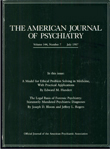Neuropsychology is a growing field in both clinical and research domains, and as a broader range of health care professionals become associated with neuropsychology, the need for a common frame of reference and a set of operational definitions becomes paramount. A Guide to Adult Neuropsychological Diagnosis has been designed as a user-friendly first attempt at providing this common frame of reference for the different professionals involved in neuropsychological diagnosis. It is an ambitious attempt to define more than 140 neuropsychological disorders, including not only clinical syndromes that are rarely seen but also those which are common. In addition to providing objective clinical indicators for each disorder, the book notes the factors that must be ruled out before making a diagnosis. Also included are associated descriptive features, lesion locations, potential etiologies, and disabling consequences. Each chapter includes a section on appropriate assessment instruments and procedures, including information on which tests are commercially available and how to order them. Information on neuropsychological treatment approaches is also included, with reference to both theoretical and practical applications. Case studies provide illustrative examples highlighting the clinical presentation of the major disorders and outlining common problems that may arise related to accurate diagnoses.
Chapter 1, primarily an introduction to the rest of the book, provides information about nomenclature and examples of clinical and research uses of the text. Chapters 2 through 19 provide descriptive classifications of major adult neuropsychological disorders. Read straight through, the book is a bit dry, but it proves itself invaluable as a reference tool. There are four separate indexes: anatomical, etiological, test, and behavioral. Through the use of the appropriate index, one can quickly find disorders that may result from damage to particular brain structures (the anatomical index), disorders that are associated with a particular disease or cause (etiological index), and disorders in which behavioral abnormalities may occur (behavioral index). Neuropsychological tests and assessment procedures can be located in the test index.
Given its index-oriented design, the book offers numerous opportunities to assist different kinds of health care professionals, across a range of levels of expertise. It will help students, interns, residents, and postdoctoral fellows in many disciplines develop skills in more accurate diagnosis, and it will promote increased understanding of neuropsychological disorders in multidisciplinary settings. The author's efforts to assist with documenting lesion localization of various disorders will be useful for understanding various disorders, planning treatment strategies, and preparing for giving depositions or court testimony when necessary. The book will also aid examiners in interpreting clinical data and making knowledgeable decisions about what to include in a comprehensive assessment. I am adding A Guide to Adult Neuropsychological Diagnosis appreciatively to my collection of neuropsychological references.

